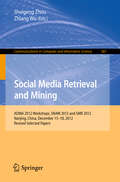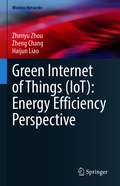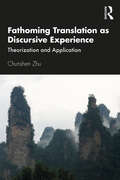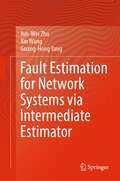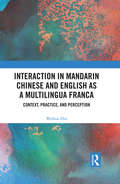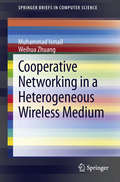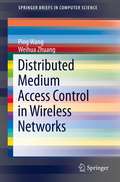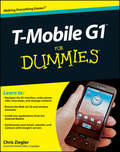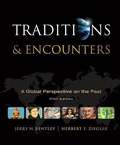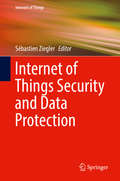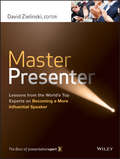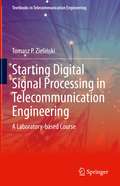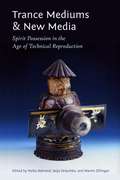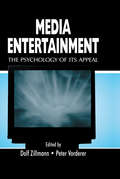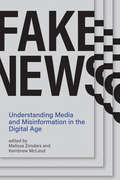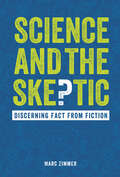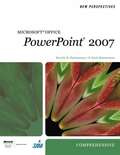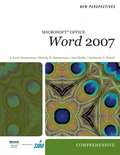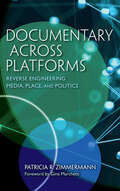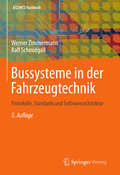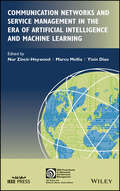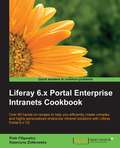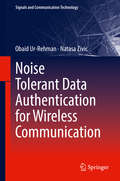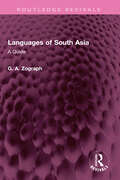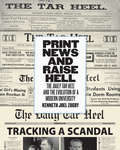- Table View
- List View
Social Media Retrieval and Mining
by Shuigeng Zhou Zhiang WuThis book constitutes the refereed proceedings of the ADMA 2012 Workshops: The International Workshop on Social Network Analysis and Mining, SNAM 2012, and the International Workshop on Social Media Mining, Retrieval and Recommendation Technologies, SMR 2012, Nanjing, China, in December 2012. The 15 revised full papers presented were carefully reviewed and selected from numerous submissions. The papers are organized in topical sections on networks and graphs processing; social Web; social information diffusion; social image retrieval and visualization.
Green Internet of Things (Wireless Networks)
by Zhenyu Zhou Zheng Chang Haijun LiaoEnergy efficiency issues for green internet of things (IoT) are investigated in this book, from the perspectives of device-to-device (D2D) communications, machine-to-machine (M2M) communications, and air-ground networks. Specifically, critical green IoT techniques from D2D communications in the cellular network to M2M communications in industrial IoT (IIoT), (from single physical-layer optimization to cross-layer optimization, and from single-layer ground networks to stereoscopic air-ground networks) are discussed in both theoretical problem formulation and simulation result analysis in this book.Internet of Things (IoT) offers a platform that enables sensors and devices to connect seamlessly in an intelligent environment, thus providing intelligence services including monitoring systems, industrial automation, and ultimately smart cities. However, the huge potentials of IoT are constrained by high energy consumption, limited battery capacity, and the slow progress of battery technology. The high energy consumption of IoT device causes communication interruption, information loss, and short network lifetime. Moreover, once deployed, the batteries inside IoT devices cannot be replaced in time. Therefore, energy efficient resource allocation is urgent to be investigated to improve the energy efficiency of IoT, facilitate green IoT, and extend the network lifetime.This book provides readers with a comprehensive overview of the state-of-the-art key technologies, frameworks, related optimization algorithms, and corresponding integrated designs on green IoT. It also presents an easy-to-understand style in a professional manner, making the book suitable for a wider range of readers from students to professionals interested in the green IoT.
Fathoming Translation as Discursive Experience: Theorization and Application
by Chunshen ZhuIn his positive approach to translation studies featured in this highly original volume, Chunshen Zhu brings into perspective from the vantage point of translation the workings of human factors in text production, interpretation, and dissemination in and through translation in varying social situations. This book examines a variety of key issues heatedly debated or largely neglected in the field of translation studies and beyond, for example, meaning making, nature of the Unit of Translation, augmentation of transitivity by modification, signification of repetition, and cognitive effects of syntactic iconicity, by critically engaging insights from functional linguistics and philosophy of language, among other fields of study. These issue-driven, phenomenon-focused, and theorization-oriented studies, presented in eight chapters with ample exemplification and case studies, form a coherent whole to bring a network of correlations between theory and practice, linguistics and literature, form and content, information structure and communicative function, intention and effect, and textuality and experience to bear upon the study of translation, fathoming its depths not only as a linguistic operation but more significantly as a textually accountable process of intersubjective and cross-lingual sign making that facilitates humans’ understanding of themselves and of the world. The book is therefore a useful reference for scholars, teachers, and postgraduate and research students who are interested in a comprehensive yet focused approach to translation as an academic subject straddling linguistics and literary, cultural, and social studies, as well as for those who would like to observe bilingualism and cross-cultural communication through translation in general and translation involving the Chinese language in particular.
Fault Estimation for Network Systems via Intermediate Estimator
by Jun-Wei Zhu Xin Wang Guang-Hong YangThis book is concerned with the fault estimation problem for network systems. Firstly, to improve the existing adaptive fault estimation observer, a novel so-called intermediate estimator is proposed to identify the actuator or sensor faults in dynamic control systems with high accuracy and convergence speed. On this basis, by exploiting the properties of network systems such as multi-agent systems and large-scale interconnected systems, this book introduces the concept of distributed intermediate estimator; faults in different nodes can be estimated simultaneously; meanwhile, satisfactory consensus performances can be obtained via compensation based protocols. Finally, the characteristics of the new fault estimation methodology are verified and discussed by a series of experimental results on networked multi-axis motion control systems. This book can be used as a reference book for researcher and designer in the field of fault diagnosis and fault-tolerant control and can also be used as a reference book for senior undergraduate and graduate students in colleges and universities.
Interaction in Mandarin Chinese and English as a Multilingua Franca: Context, Practice, and Perception
by Weihua ZhuInteraction in Mandarin Chinese and English as a Multilingua Franca: Context, Practice, and Perception proposes a model of context, practice, and perception and raises awareness of the importance of understanding language use and perception in context in order to avoid intercultural communication misunderstandings. This book provides an overview of previous research on the pragmatics of Chinese and English as a multilingua franca in multilingual contexts. It argues that context is socioculturally shaped, interactionally constructed, and personally related. Context can influence and be established by the practice and perception of communicative acts. This book also combines the proposed model with the discursive-interactional approach to uncover the interplay of context, practice, and perception of extended concurrent speech for strong disagreement by native Chinese speakers in spontaneous conversations in Mandarin and English as a multilingua franca.
Cooperative Networking in a Heterogeneous Wireless Medium (SpringerBriefs in Computer Science)
by Weihua Zhuang Muhammad IsmailThis brief focuses on radio resource allocation in a heterogeneous wireless medium. It presents radio resource allocation algorithms with decentralized implementation, which support both single-network and multi-homing services. The brief provides a set of cooperative networking algorithms, which rely on the concepts of short-term call traffic load prediction, network cooperation, convex optimization, and decomposition theory. In the proposed solutions, mobile terminals play an active role in the resource allocation operation, instead of their traditional role as passive service recipients in the networking environment.
Distributed Medium Access Control in Wireless Networks
by Weihua Zhuang Ping WangThis brief investigates distributed medium access control (MAC) with QoS provisioning for both single- and multi-hop wireless networks including wireless local area networks (WLANs), wireless ad hoc networks, and wireless mesh networks. For WLANs, an efficient MAC scheme and a call admission control algorithm are presented to provide guaranteed QoS for voice traffic and, at the same time, increase the voice capacity significantly compared with the current WLAN standard. In addition, a novel token-based scheduling scheme is proposed to provide great flexibility and facility to the network service provider for service class management. Also proposed is a novel busy-tone based distributed MAC scheme for wireless ad hoc networks and a collision-free MAC scheme for wireless mesh networks, respectively, taking the different network characteristics into consideration. The proposed schemes enhance the QoS provisioning capability to real-time traffic and, at the same time, significantly improve the system throughput and fairness performance for data traffic, as compared with the most popular IEEE 802.11 MAC scheme.
T-Mobile G1 For Dummies
by Chris ZieglerExcited about the new Google phone? T-Mobile's G1 android phone is packed with possibilities, and T-Mobile G1 For Dummies will help you make the most of them.This fun and friendly guide shows you how to navigate the G1's android interface, make phone calls, view maps, manage contacts, browse the Web, and a whole lot more. Your T-Mobile G1 is so much more than a phone--it's also an administrative assistant, movie theater, jukebox, mobile office, and several more things all rolled into one device. With T-Mobile G1 For Dummies, you can:Find out all about the Android smartphone operating system and what it offersLearn your way around the G1's keyboard, buttons, and touch screenSee how your G1 connects to both Wi-Fi networks and T-Mobile's high-speed networkSurf the Web, download music and picture files, and tweak browser settingsSend and receive Gmail, get where you're going with Google Maps, and stay organized with Google CalendarTake photos, check out YouTube, and fill your phone with mediaManage your e-mail and choose which messages will be synced to your phoneShop the Android Market and discover more cool apps for your G1Don't waste a single cool feature of your T-Mobile G1! T-Mobile G1 For Dummies shows you how to use all the great Google functions, play (and even buy) music, browse the Web, add apps, and more.
Traditions and Encounters: A Global Perspective on the Past (5th Edition)
by Herbert F. Ziegler Jerry H. BentleyConnect students to the stories of history. Connect students to the experience of history. Connect students to success in history. At McGraw-Hill, we have dedicated the past few years to deepening our understanding of student and instructor experience. Employing a wide array of research tools including surveys, focus groups, and ethnographic studies, we've identified areas in need of improvement to provide an opportunity for greater learning and teaching experiences. The fifth edition of Traditions & Encounters is a result of this. Traditions & Encounters also has a rich history of firsts: the first world history text to take a truly global perspective on the past; the first to emphasize connections among cultures; the first to combine twin themes with a seven-part framework, making the huge story of world history more manageable to both teach and learn. Now Traditions & Encounters becomes the first truly interactive world history program: one that marries groundbreaking adaptive diagnostics and interactivities with a captivating narrative and engaging visuals, creating a unique learning environment that propels greater student success and better course results. Instructors gain insight into students' engagement and understanding as students develop a base of knowledge and construct critical thinking skills. Chapter-opening vignettes and a lively narrative keep students turning the page while the adaptive questioning for each chapter and the personalized study plan for each individual student help students prepare for class discussions and course work. With its hallmark of twin themes, Traditions & Encounters continues to tell the story of the cultures and interactions that have shaped world history, while adding redesigned maps, new primary sources, and new chapter- and part-level features that strengthen connections and prompt students to analyze the events and themes in order to build a greater understanding of the past and an appreciation of history's influence on the present. Students are no longer simply reading; they are reading, interacting, and engaging in a visual, auditory, and hands-on learning experience. Give students an experience. Improve course participation and performance. Experience Traditions & Encounters, and experience success.
Internet of Things Security and Data Protection (Internet of Things)
by Sébastien ZieglerThis book provides an overview of the most recent developments in Internet of Things (IoT) security and data protection. It presents the results of several international research projects addressing this topic from complementary angles. It starts by analyzing the main privacy and security threats on IoT, as well as the evolution of data protection norms, such as the European General Data Protection Regulation (GDPR), and their impact on IoT. Through a comprehensive and systematic approach, the contributors present new perspectives on IoT & Cloud Computing security requirements. They discuss the most recent approach to support trusted IoT, including new models of privacy risk assessment, labeling and certification, and contractual tools (such as Privacy PACT). Practical implementations, such as in the European Large Scale Pilots on IoT for Smart Cities (Synchronicity), are presented, explaining how they address security, privacy and data protection. Finally, innovative models to secure IoT systems are presented for the network and end-nodes security, including network threats analysis.
Master Presenter: Lessons from the World's Top Experts on Becoming a More Influential Speaker
by David ZielinskiFor anyone who wants to become a more persuasive and tech-savvy presenter, Master Presenter offers an accessible collection of the best tips, tactics, and hard-won lessons from top presentation skill coaches who write for PresentationXpert newsletter. Designed to be a hands-on resource, the book includes advice drawn from real-world, time-starved businesspeople who create compelling presentations that get results. Now, you too can tap into the power of the little-used, but valuable features of PowerPoint® that can save time or enhance slide design and make your presentation stand out in a crowd. This groundbreaking book also includes practical advice on getting the most from mobile devices to enhance presentations and shows how to apply social media tools like Twitter to aid in delivering compelling messages. Learn how web conferencing can be used not only to reduce travel costs, but to deliver more effective informational, training or motivational presentations across time zones. In addition to putting the spotlight on the high-tech, Master Presenter contains valuable information on the critical low-tech presentation skills. Contributors show how to best use your voice, hands, and body and what it takes to move your listeners to take action when making a well-prepared pitch. And even if you are inexperienced, you can use the book's techniques to become a great storyteller that will win over audiences and help earn you a reputation as a master presenter. Praise for Master Presenter "Master Presenter arms you with the method and magic to present with poise and power. David Zielinski has assembled the best and brightest mentors to teach greatness in business presenting." —Chip R. Bell, author of Managers as Mentors "Master Presenter is the most comprehensive collection of useful articles I've ever seen in one place. After reading more than 200 books on public speaking in my lifetime and teaching the subject in eight countries, I can easily recommend this book for beginners and seasoned speakers. Great tips on PowerPoint®, for example, with dozens of articles and illustrations on all aspects of speaking by leaders in the field." —Michael Buschmohle, president, Applause Associates "As a 30-year veteran of presenting and a certified professional facilitator, I found myself reading through this book's articles and still gaining new insights into things I can do to improve my presentations. I was impressed by the perspectives shared by this top-notch team of experts. This is one of the few books I would strongly recommend to my network of customers, who are purchasers of facilitation and engagement tools." —Dr. Scott Simmerman, managing partner, Performance Management Company "I make presentations for a living and I've been doing it for a long time, but I'm keeping a copy of this book within reach on my desk at all times. I could have used it when I was starting out, but I also have learned enough over the years to recognize how valuable this book will be as an ongoing and wide-ranging resource for telling compelling stories." —Brian McDermott, co-author of Leading Innovation and Time Out for Leaders
Starting Digital Signal Processing in Telecommunication Engineering: A Laboratory-based Course (Textbooks in Telecommunication Engineering)
by Tomasz P. ZielińskiThis hands-on, laboratory driven textbook helps readers understand principles of digital signal processing (DSP) and basics of software-based digital communication, particularly software-defined networks (SDN) and software-defined radio (SDR). In the book only the most important concepts are presented. Each book chapter is an introduction to computer laboratory and is accompanied by complete laboratory exercises and ready-to-go Matlab programs with figures and comments (available at the book webpage and running also in GNU Octave 5.2 with free software packages), showing all or most details of relevant algorithms. Students are tasked to understand programs, modify them, and apply presented concepts to recorded real RF signal or simulated received signals, with modelled transmission condition and hardware imperfections. Teaching is done by showing examples and their modifications to different real-world telecommunication-like applications. The book consists of three parts: introduction to DSP (spectral analysis and digital filtering), introduction to DSP advanced topics (multi-rate, adaptive, model-based and multimedia - speech, audio, video - signal analysis and processing) and introduction to software-defined modern telecommunication systems (SDR technology, analog and digital modulations, single- and multi-carrier systems, channel estimation and correction as well as synchronization issues).Many real signals are processed in the book, in the first part – mainly speech and audio, while in the second part – mainly RF recordings taken from RTL-SDR USB stick and ADALM-PLUTO module, for example captured IQ data of VOR avionics signal, classical FM radio with RDS, digital DAB/DAB+ radio and 4G-LTE digital telephony. Additionally, modelling and simulation of some transmission scenarios are tested in software in the book, in particular TETRA, ADSL and 5G signals.Provides an introduction to digital signal processing and software-based digital communication;Presents a transition from digital signal processing to software-defined telecommunication;Features a suite of pedagogical materials including a laboratory test-bed and computer exercises/experiments.
Trance Mediums and New Media: Spirit Possession in the Age of Technical Reproduction
by Martin Zillinger Heike Behrend Anja DreschkeOngoing debates about the “return of religion” have paid little attention to the orgiastic and enthusiastic qualities of religiosity, despite a significant increase in the use of techniques of trance and possession around the globe. Likewise, research on religion and media has neglected the fact that historically the rise of mediumship and spirit possession was closely linked to the development of new media of communication. This innovative volume brings together a wide range of ethnographic studies on local spiritual and media practices. Recognizing that processes of globalization are shaped by mass mediation, the volume raises questions such as: How are media like photography, cinema, video, the telephone, or television integrated in seances and healing rituals? How do spirit mediums connect with these media? Why are certain technical media shunned in these contexts?
Media Entertainment: The Psychology of Its Appeal (Routledge Communication Series)
by Dolf Zillmann Peter VordererThis collection represents a systematic exploration of media entertainment from an academic perspective. Editors Zillmann and Vorderer have assembled scholars from psychology, sociology, and communication to provide a broad examination of the primary function of media entertainment--the attainment of gratification. Chapters included here address vital aspects of media entertainment and summarize pertinent findings, providing an overview of what is presently known about the appeal and function of the essential forms of media entertainment, and offering some degree of integration. Written in a clear, non-technical style, this volume provides a lively and entertaining study of media entertainment for academic study and coursework.
Fake News: Understanding Media and Misinformation in the Digital Age (Information Policy)
by Melissa Zimdars Kembrew McLeodNew perspectives on the misinformation ecosystem that is the production and circulation of fake news.What is fake news? Is it an item on Breitbart, an article in The Onion, an outright falsehood disseminated via Russian bot, or a catchphrase used by a politician to discredit a story he doesn't like? This book examines the real fake news: the constant flow of purposefully crafted, sensational, emotionally charged, misleading or totally fabricated information that mimics the form of mainstream news. Rather than viewing fake news through a single lens, the book maps the various kinds of misinformation through several different disciplinary perspectives, taking into account the overlapping contexts of politics, technology, and journalism.The contributors consider topics including fake news as “disorganized” propaganda; folkloric falsehood in the “Pizzagate” conspiracy; native advertising as counterfeit news; the limitations of regulatory reform and technological solutionism; Reddit's enabling of fake news; the psychological mechanisms by which people make sense of information; and the evolution of fake news in America. A section on media hoaxes and satire features an oral history of and an interview with prankster-activists the Yes Men, famous for parodies that reveal hidden truths. Finally, contributors consider possible solutions to the complex problem of fake news—ways to mitigate its spread, to teach students to find factually accurate information, and to go beyond fact-checking.ContributorsMark Andrejevic, Benjamin Burroughs, Nicholas Bowman, Mark Brewin, Elizabeth Cohen, Colin Doty, Dan Faltesek, Johan Farkas, Cherian George, Tarleton Gillespie, Dawn R. Gilpin, Gina Giotta, Theodore Glasser, Amanda Ann Klein, Paul Levinson, Adrienne Massanari, Sophia A. McClennen, Kembrew McLeod, Panagiotis Takis Metaxas, Paul Mihailidis, Benjamin Peters, Whitney Phillips, Victor Pickard, Danielle Polage, Stephanie Ricker Schulte, Leslie-Jean Thornton, Anita Varma, Claire Wardle, Melissa Zimdars, Sheng Zou
Science and the Skeptic: Discerning Fact from Fiction
by Marc ZimmerFake news, pseudoscience, and quackery have become scourges, spreading through society from social media all the way to Congress. The line between entertainment and reality, between fact and fiction, has become blurred. Some of the most crucial issues of our time—climate change, vaccines, and genetically modified organisms—have become prime targets for nefarious disinformation campaigns. Far too many people have become distrustful of real science. Even those who still trust science no longer know what to believe or how to identify the truth. Not only does this result in the devaluation and distrust of real science, but it is also dangerous: people acting based on false information can hurt themselves or those around them. We must equip ourselves with the knowledge and skills to fight back against all this disinformation. InScience and the Skeptic: Discerning Fact from Fiction, you will learn how science is done, from the basic scientific method to the vetting process that scientific papers must go through to become published; how and why some people intentionally or unintentionally spread misinformation; and the dangers in believing and spreading false information. You'll also find twenty easy-to-follow rules for distinguishing fake science from the real deal. Armed with this book, empower yourself with knowledge, learning what information to trust and what to dismiss as deceit. "We're not just fighting an epidemic; we're fighting an infodemic. . . . This is a time for facts, not fear. This is a time for rationality, not rumors. This is a time for solidarity, not stigma."—Tedros Adhanom Ghebreyesus, director-general of the WHO "Our deepest beliefs should help navigate reality, not determine it."—Michael Gersen, The Washington Post "Journalism is very much about trying to simplify and distribute information about what's new and where advances have been made. That's incompatible with the scientific process, which can take a long time to build a body of evidence."—Kelly McBride, Poynter Institute
New Perspectives on Microsoft® Office PowerPoint® 2007: Comprehensive
by Beverly B. Zimmerman S. Scott ZimmermanFollowing the critical thinking, problem-solving approach of the New Perspectives Series learners will gain a comprehensive understanding of Microsoft PowerPoint 2007, including the new features of the software. The case-based tutorials challenge learners to apply what they are learning to real-life tasks, preparing them to easily transfer skills to new situations. With the New Perspectives Series approach, learners understand why they're learning what they're learning, and are better situated to retain skills.
New Perspectives on Microsoft® Office Word 2007: Comprehensive
by S. Scott Zimmerman Beverly B. Zimmerman Ann Shaffer Katherine T. PinardFollowing the critical thinking, problem-solving approach of the New Perspectives Series learners will gain a comprehensive understanding of Microsoft Word 2007, including the new features of the software. The case-based tutorials challenge learners to apply what they are learning to real-life tasks, preparing them to easily transfer skills to new situations. With the New Perspectives Series approach, learners understand why they?re learning what they?re learning, and are better situated to retain skills.
Documentary Across Platforms: Reverse Engineering Media, Place, and Politics
by Patricia R. ZimmermannEssays “capturing media ecologies as varied as museum installations, film festival showings, photography, and multiple varieties of internet sharing.” —Jump CutIn Documentary Across Platforms, noted scholar of film and experimental media Patricia R. Zimmermann offers a glimpse into the ever-evolving constellation of practices known as “documentary” and the way in which they investigate, engage with, and interrogate the world.Collected here for the first time are her celebrated essays and speculations about documentary, experimental, and new media published outside of traditional scholarly venues. These essays envision documentary as a complex ecology composed of different technologies, sets of practices, and specific relationships to communities, engagement, politics, and social struggles. Through the lens of reverse engineering—the concept that ideas, just like objects, can be disassembled to learn how they work and then rebuilt into something new and better—Zimmermann explores how numerous small-scale documentary works present strategies of intervention into existing power structures. Adaptive to their context, modular, and unfixed, the documentary practices she explores exploit both sophisticated high-end professional and consumer-grade amateur technologies, moving through different political terrains, different platforms, and different exhibition contexts.Together these essays demonstrate documentary’s role as a conceptual practice to think through how the world is organized and to imagine ways that it might be reorganized with actions, communities, and ideas.
Bussysteme in der Fahrzeugtechnik: Protokolle, Standards und Softwarearchitektur (ATZ/MTZ-Fachbuch)
by Werner Zimmermann Ralf SchmidgallDieses Fachbuch gibt einen Überblick über die in der Kfz-Elektronik verbreiteten Bussysteme wie CAN, FlexRay, LIN oder MOST, deren Protokolle und die Softwarearchitektur moderner Steuergeräte. Die Beschreibung erfolgt aus der Sicht von Ingenieuren, die diese Systeme in der Praxis einsetzen und in Fahrzeuge integrieren müssen. Ausführlich wird auf die höheren Schichten der ISO, SAE und ASAM-Transport- und Diagnoseprotokolle sowie deren Anwendung eingegangen. Neben der Kommunikation wird die Softwarearchitektur der Steuergeräte mit Betriebssystem und Basissoftware vorgestellt, wie sie im Rahmen von AUTOSAR, OSEK/VDX und HIS definiert werden.Neu in dieser Auflage wurden CAN FD, Automotive Ethernet, OTX und WWH-OBD aufgenommen.
Communication Networks and Service Management in the Era of Artificial Intelligence and Machine Learning (IEEE Press Series on Networks and Service Management)
by Nur Zincir-HeywoodCOMMUNICATION NETWORKS AND SERVICE MANAGEMENT IN THE ERA OF ARTIFICIAL INTELLIGENCE AND MACHINE LEARNING Discover the impact that new technologies are having on communication systems with this up-to-date and one-stop resource Communication Networks and Service Management in the Era of Artificial Intelligence and Machine Learning delivers a comprehensive overview of the impact of artificial intelligence (AI) and machine learning (ML) on service and network management. Beginning with a fulsome description of ML and AI, the book moves on to discuss management models, architectures, and frameworks. The authors also explore how AI and ML can be used in service management functions like the generation of workload profiles, service provisioning, and more. The book includes a handpicked selection of applications and case studies, as well as a treatment of emerging technologies the authors predict could have a significant impact on network and service management in the future. Statistical analysis and data mining are also discussed, particularly with respect to how they allow for an improvement of the management and security of IT systems and networks. Readers will also enjoy topics like: A thorough introduction to network and service management, machine learning, and artificial intelligence An exploration of artificial intelligence and machine learning for management models, including autonomic management, policy-based management, intent based management, and network virtualization-based management Discussions of AI and ML for architectures and frameworks, including cloud systems, software defined networks, 5G and 6G networks, and Edge/Fog networks An examination of AI and ML for service management, including the automatic generation of workload profiles using unsupervised learning Perfect for information and communications technology educators, Communication Networks and Service Management in the Era of Artificial Intelligence and Machine Learning will also earn a place in the libraries of engineers and professionals who seek a structured reference on how the emergence of artificial intelligence and machine learning techniques is affecting service and network management.
Liferay 6.x Portal Enterprise Intranets Cookbook
by Katarzyna Ziolkowska Piotr FilipowiczIf you are a Java developer or administrator with a technical background and want to install and configure Liferay Portal as an enterprise intranet, this is the book for you. In short, reusable recipes help you realize business goals as working features in Liferay. This book will also give you useful hints on how to easily improve the default functionality of the system and its performance.
Noise Tolerant Data Authentication for Wireless Communication (Signals And Communication Technology)
by Natasa Zivic Obaid Ur-RehmanThis book provides insight into the challenges in providing data authentication over wireless communication channels. The authors posit that established standard authentication mechanisms – for wired devices – are not sufficient to authenticate data, such as voice, images, and video over wireless channels. The authors propose new mechanisms based on the so-called soft authentication algorithms, which tolerate some legitimate modifications in the data that they protect. The authors explain that the goal of these algorithms is that they are tolerant to changes in the content but are still able to identify the forgeries. The authors go on to describe how an additional advantage of the soft authentication algorithms is the ability to identify the locations of the modifications and correct them if possible. The authors show how to achieve this by protecting the data features with the help of error correcting codes. The correction methods are typically based on watermarking, as the authors discuss in the book.Provides a discussion of data (particularly image) authentication methods in the presence of noise experienced in wireless communication;Presents a new class of soft authentication methods, instead of the standard hard authentication methods, used to tolerate minor changes in image data;Features authentication methods based on the usage of authentication tags as well as digital watermarks.
Languages of South Asia: A Guide (Routledge Revivals)
by G. A. ZographFirst published in 1982, Languages of South Asia covers all important languages and language groups of the so-called Indian subcontinent (India, Bangladesh, Pakistan, Sri Lanka, Nepal and Bhutan). It concentrates on the more southern languages, that is the Indo-Aryan, Dravidian and Munda groups; a brief survey of Tibeto-Burman languages is also included. As well as giving a description of the current status and character of each language, Dr. Zograph goes into a detailed structural analysis of its phonology, morphology and syntax. The problems of the historical background of the modern languages, and their classification, are also discussed. The book is supplemented by two language maps, tables showing the main alphabets, a bibliography of reliable works on the subject and an index of 350 language names used in the text. This book will be of interest to students of language, linguistics and South Asian studies.
Print News and Raise Hell: The Daily Tar Heel and the Evolution of a Modern University
by Kenneth Joel ZogryFor over 125 years, the Daily Tar Heel has chronicled life at the University of North Carolina at Chapel Hill and at times pushed and prodded the university community on issues of local, state, and national significance. Thousands of students have served on its staff, many of whom have gone on to prominent careers in journalism and other influential fields. Print News and Raise Hell engagingly narrates the story of the newspaper's development and the contributions of many of the people associated with it. Kenneth Joel Zogry shows how the paper has wrestled over the years with challenges to academic freedom, freedom of speech, and freedom of the press, while confronting issues such as the evolution of race, gender, and sexual equality on campus and long-standing concerns about the role of major athletics at an institution of higher learning. The story of the paper, the social media platform of its day, uncovers many dramatic but perhaps forgotten events at UNC since the late nineteenth century, and along with many photographs and cartoons not published for decades, opens a fascinating window into Tar Heel history. Examining how the campus and the paper have dealt with many challenging issues for more than a century, Zogry reveals the ways in which the history of the Daily Tar Heel is deeply intertwined with the past and present of the nation's oldest public university.
